| February 5, 2015 |
Field Crops 28.4 - 122
|
|
|
Do We Grow Another Bushel or Save a Buck?
Joe Lauer, Corn Agronomist
The obvious answer is, "Yes!" Most of us try to do both.
However, the predictions for the 2015 cropping season are for lower corn prices. Farmers wonder whether they should continue trying to increase production on their farms or should they cut costs and try to save a buck by not going after the most expensive yield. This article reviews some of the important decisions that growers need to make as plans are made for lower corn prices in 2015.
As farmers consider the impact of the most yield limiting factors, it isn't always about inputs and cutting costs. The most important management decision is hybrid selection. The choice of hybrid increasingly dictates management decisions farmers make during a growing season. After the hybrid is selected the main management objective is to reduce stress on corn plants during the growing season.
In many ways we are "back to the future." Corn prices are not as bad as the 1990s and early 2000s, but they are projected to decrease nearly 50% from recent prices. Frugal innovation may be required. When corn prices are low farmers must: 1) know their cost of production for
corn, 2) concentrate on the basics, 3) realize that timing of operations is everything, and 4) question every input in their production practices. An increased reliance on scouting for in-season decisions and corrections will increase efficiencies during years of low corn prices.
It is very difficult to get a handle on the cost of production of a crop enterprise.
We do know from PEPS data that two inputs that have increased dramatically over the last 25 years. From the 1987 to 2011 seed cost has increased 4 to 5 times. Fertilizer inputs have increased 2 to 3 times. Chemical and equipment costs have remained relatively flat. Harvesting costs fluctuate with the year, becoming higher in cold, wet seasons due to higher drying costs. The cost of land has increased dramatically in the last five years. Using PEPS and USDA data the cost of production of corn in Wisconsin is around $550 to $700 per acre.
Crop production decisions can be divided into
categorical and continuous decisions. Examples of categorical decisions are hybrid selection, seed treatment, rotation, tillage, weed
control, harvest timing, land, marketing, drainage, and equipment. Examples of continuous decisions are plant density, planting date, soil fertility (N, P, K, micronutrients, and lime), irrigation and scouting (effort). Many other minor decisions must be made that often interact with other decisions.
An example of a continuous input cost is plant density (Figure 1). Like most continuous decisions, plant density costs increase in a linear fashion as the amount of seed planted increases. The yield response of corn to plant density is typically curvilinear. The point on the yield curve where yield is greatest is called maximum yield (MY). The plant density where the distance between input cost and the yield curve is greatest is called the economic optimum (EO). The plant density where yield equals input cost is the equilibrium (EQ) yield where farmers make no profit. Where the yield response intercepts the y-axis is the yield (Y0) level with no input. In the example using plant density, zero plants equal zero yield. Often some grain yield results with no input. For example, nitrogen is continuously mineralized from the soil so even though no nitrogen fertilizer may be applied, some yield can still
be achieved. Other decisions like fungicide, tillage and row spacing have little impact on the yield curve.
Figure 1. Determining Maximum Yield v. Economic Optimum Yield.
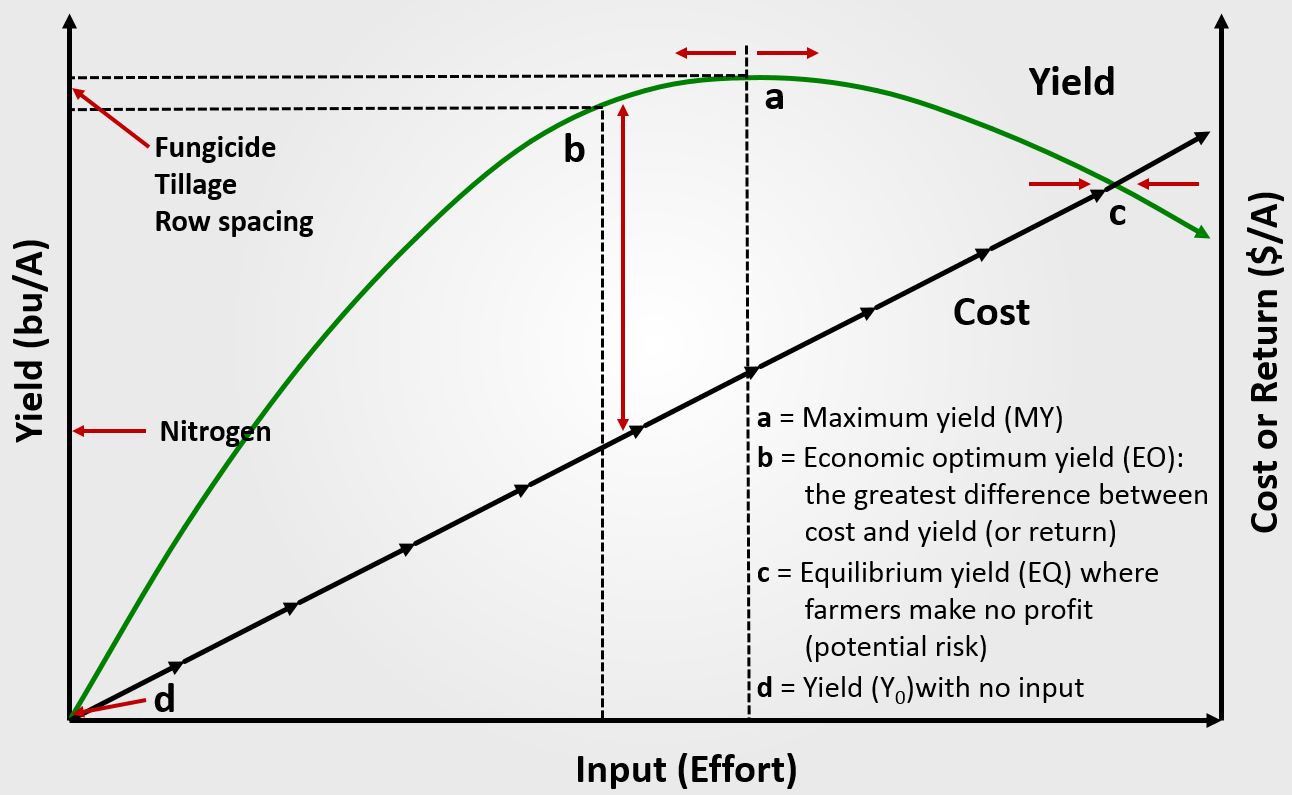
In corn production, the most important variable with the least management control is weather. We have to accept the fact that Mother Nature has the upper hand. Management decisions and timing are continuously impacted by weather. Drainage is critical in the spring. Crops in the Midwest are challenged by 1) cool, wet springs that often result in lack of root surface area, and 2) dry, hot summer conditions during pollination, kernel set and grain filling. The corn crop grows best in a spring dry enough for early planting, but wet enough to activate herbicides and promote good stands with uniform emergence. Summers should have timely rain of about 1 inch per week, lots of sunshine, and temperatures in the mid-80s during the day and low-60s during the night. Falls should have sunny dry weather to speed dry down and allow harvest of grain at 22% moisture by November 1.
Figure 2 shows data from Lancaster in plots where no nitrogen has been applied since 1966. The average yield of these continuous
corn plots is around 50 bu/A. In other rotations involving corn-soybean and corn-soybean-oats-alfalfa yield is at a higher level with zero nitrogen. For the most extended rotation yield has been increasing over time.
Figure 2. Corn Yield at 0 lb N/A for continuous corn, corn-soybean, and corn-soybean-corn-oat-alfalfa rotation at Lancaster, WI. Plots were established in 1966.
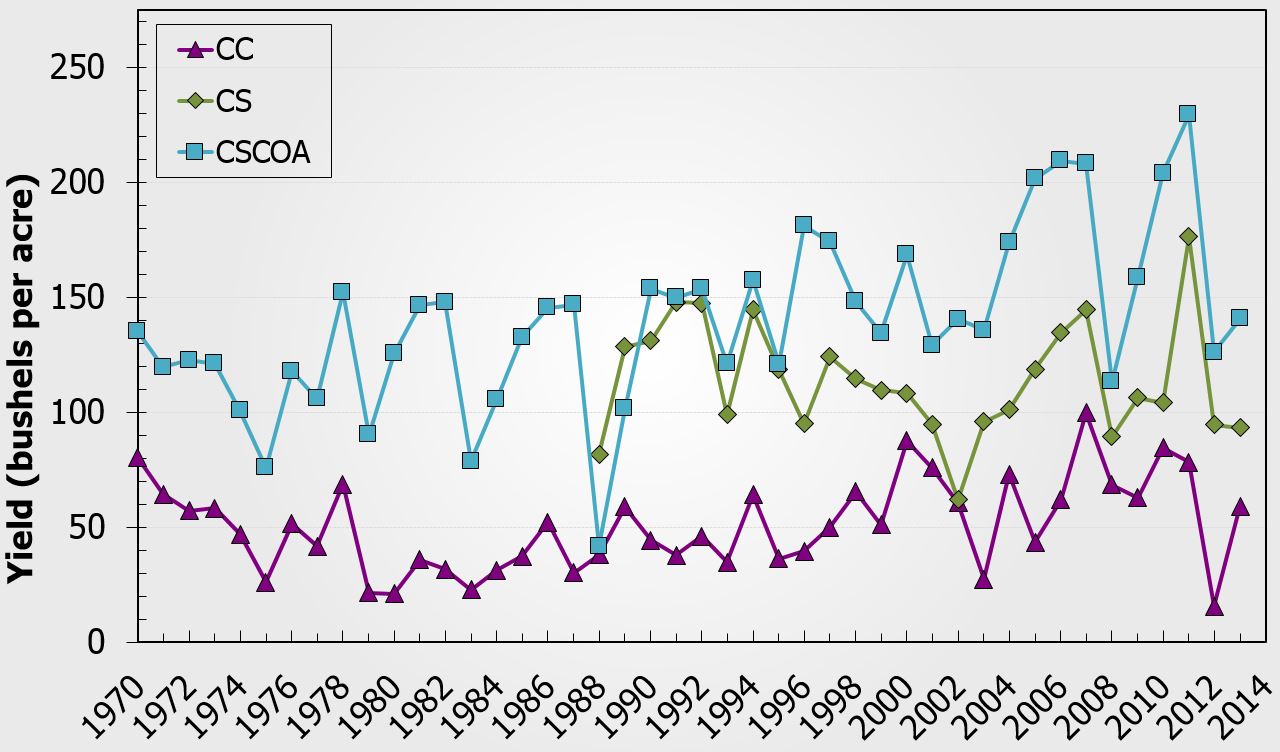
Corn hybrid selection is arguably the most important management decision a farmer makes because increasingly the choice of hybrid dictates management. The principles of hybrid selection include: 1) using independent yield trial data and multi-location averages, 2) evaluate consistency of performance, 3) pay attention to seed costs, 4) recognize that every hybrid must stand on its own for performance, and 5) buy the traits you need. Remember that traits do not add to yield, traits protect yield. The UW hybrid evaluation program has conducted 939 corn hybrid trials since 1973. The average yield of these trials is 165 bushels per acre. The difference between the top yielding
hybrid and the bottom yielding hybrid in a trial is 70 bushels per acre. If you divide to 70 into 165 the average yield swing for a hybrid selection decision is 42%.
In the UW corn hybrid trials, the average yield of conventional hybrids is currently equal to the trial average. There was a period of time between 2001 and 2009 where the average yield of conventional hybrids was up to 10 bushels per acre below the trial average. Since 2010 conventional hybrids have yielded similar to the trial average in four of five years; the only exception being the drought year of 2012.
For corn production in Wisconsin a seed treatment is needed and should be applied to the seed of the hybrid selected. Untreated check seed typically has 20 to 25% seed death. Use of seed treatments decrease the amount of seed death to 5 to 10%. There are many options available to farmers.
The crop rotation decision provides the easiest yield a farmer can get. In our UW trials corn yield increases 10 to 19% when rotated was citing. The rotation effect last at most two years and depends upon the length of the break between the crops of interest. If you have two or more break years then yield of the second year of the continuous crop will be greater than the yield of continuous crops. If only one break year is grown then the yield of the second year equals that of continuous cropping. The rotation effect is even more dramatic and
stressful years. In figure the rotation effect lasts two years increasing corn grain yield 15 to 17% for rotated according first-year corn following five users arriving in 6% for second-year corn. Conventional tillage increases corn yields about 4% however there is an interaction that occurs which we will come back to later.
Figure 3. The rotation effect of corn following soybean in Conventional-(CT) and No-Tillage (NT) at Arlington during 1994-2013.
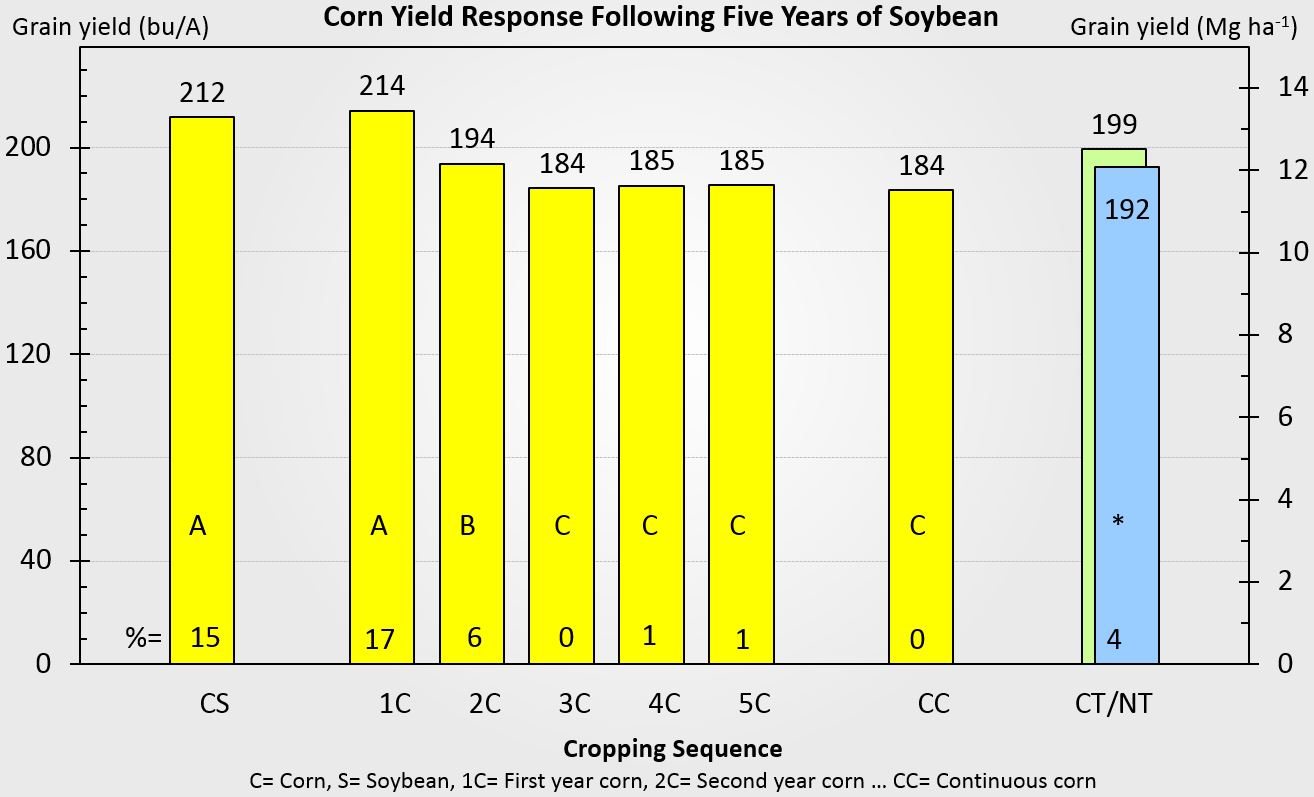
Planting date is a "priceless" decision because it sets up management timing for other inputs during the season. If a farmer is forced to plant late, then a "double whammy" results with lower yield and higher grain moisture. To begin planting, growers need to focus on seedbed conditions and calendar date rather than on soil temperature. Follow local extension recommendations especially as they relate to crop insurance requirements. Disadvantages of early planting including increased seedling diseases, soil crusting, late spring frosts, and European corn borer problems. At Arlington the planting date that produces maximum grain yield is
April 28 (Figure 4). The planting date when maximum yield is achieved ranges from April 10 to May 3 depending upon the year. Yield is still at 95% of the maximum yield as late as May 12-19. Grain yield decreases 0.9 bushels per acre per day on May 10 and accelerates to 2.6 bushels per acre per day on June 1.
Figure 4. Corn response to planting date during 2003 to 2012 at Arlington, WI.

Fertilizer, especially nitrogen, is not the place to cut costs. Farmers should soil test and efficiently apply needed nutrients using the cheapest form of fertilizer per unit of nitrogen, phosphorus, potassium. Using manure and legume credits can help reduce purchased fertilizer costs. Don't cut back on overall nitrogen supplied unless you have been over applying. Do not use micronutrients unless soil test recommendations encourage it. The most economical approach to this decision is the maximum return to nitrogen (MRTN) approach. This approach accounts for corn price and nitrogen cost. The amount of nutrients removed by corn at harvest is 67 pounds phosphate per acre and 51 pounds potash per acre for a 175 bushel yield. For a silage yield of 24 tons per acre, 86 pounds phosphate per acre and 199 pounds potash per acre is removed. These nutrients eventually need to be replaced.
Plant distribution in the field is determined by plant density and row spacing. Plant density has the most potential to move a farmer from their current yield levels. Maximum yield plant densities are increasing over time as newer hybrids are commercialized. For most farms in Wisconsin narrower row spacing (15- to 20- inches) is better than row spacings of 36- to 38-inches,
however, this decision has relatively low impact on yield.
The
effect of plant density on corn grain and forage yield is shown in Figure 5. The response is fairly "broad-shouldered" in that 95% of the maximum for these measurements can be achieved at 26,000 to 32,000 plants per acre. The plant density that maximizes grain yield is 39,000 plants per acre. The economic optimum plant density is about 4000 plants per acre less at 35,000 plants per acre. The economic optimum is calculated using a partial budget approach where yield is mutlipleid by a corn price determined using the PEPS method and costs are subtracted (handling= $0.02/bu, hauling= $0.04/bu, trucking= $0.11/bu, storage= $0.02 per month/bu, drying= $0.02 per point/bu > 15.5% moisture, and seed cost = $250 per 80K bag).
Forage yield continues to increase up to about 48,000 plants per acre. However there is a yield and quality trade-off. As plant density increases forage quality, as measured by Milk per ton decreases. So the economic optimum for silage, as measured by Milk per acre, is about 6000 plants per acre greater than the grain maximum yield plant density.
Figure 5. Relationship between corn plant density and grain maximum yield, grain economic optimum, forage yield, Milk/Ton, and Milk/Acre. Data are derived from studies conducted between 2005 and 2014 at Arlington, WI.

Pest control is an important series of decisions in corn production. For most major corn pests, economic injury levels and economic threshold levels are known. In corn weeds are considered more of a problem than insects, and insects are more of a problem than
diseases. Plant breeders have done a good job of developing corn hybrids resistant to insect and disease pressure.
We have a number of emerging pest resistance issues in Wisconsin. In southeast Wisconsin corn rootworm resistance has developed to Bt traited corn. In 2014, gylphosate (Roundup) resistance in waterhemp and Palmer amaranth. Finally, there is an increased awareness of nematode issues.
Early-season weed competition can significantly reduce yield in high-yield environments. In a Nebraska study, delaying weed control reduced yield if weeds were not controlled by V5.
For insect management it's all about scouting and timing. Insects are adapting to our cropping practices and they will likely continue to evolve.
For disease management the goal is to improve the corn canopy leading to yield increase and disease decrease. Genetic resistance is the cheapest form of control. Scout for these diseases in particular: anthracnose, northern corn leaf blight, diplopia, and Fusarium/ Gibberella. Recently, foliar fungicides have become more widely used. However, in our research only 2 of 32 studies significantly increased corn yield with fungicide use.
Tillage used to be about controlling weeds and seedbed preparation. Now it is all about stand establishment. We have excellent herbicides. We have had numerous planter technology developments. The tillage response is more often measured in the northern Corn Belt. Conventional tillage increases grain yield 5 to 7% over no-tillage. There is less difference observed between tillage systems when using Roundup ready crops. However, there is an interaction in that tillage does not affect corn yield in rotated corn and first-year corn following five years of soybean, but improves yield in second-year corn 5%. So tillage is not necessary in rotated corn, but becomes increasingly important as the number of years of continuous corn increase. So don't throw away your chisel plow. There may be years where the economics favor continuous corn production.
Figure 6. The interaction between conventional tillage and notill at Arlington during 1994 to 2013.
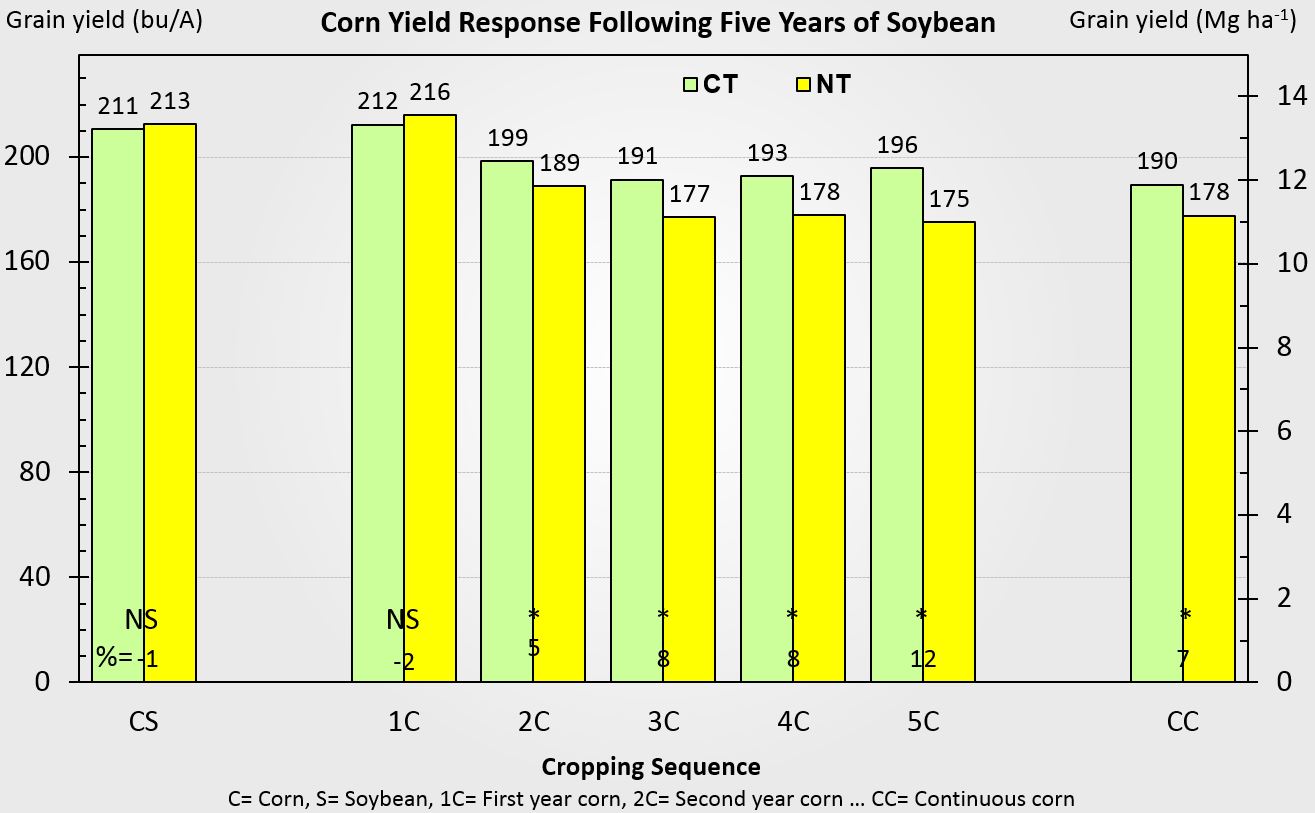
Finally harvest and store your crop carefully. There's a trade-off between field losses and drying costs. The recommend harvest moisture range is between 20 and 25% moisture. Large field losses can occur with lodging and ear droppage. For safe storage corn must be dried below 15% moisture, so some drying is often needed after harvest. We still have about 20-25% of the acres in NE Wisconsin still standing in the field. By November 1 most of the corn grain drydown has occurred (Figure 7).
Figure 7.
Grain moisture drydown of corn left standing in the field at Arlington.
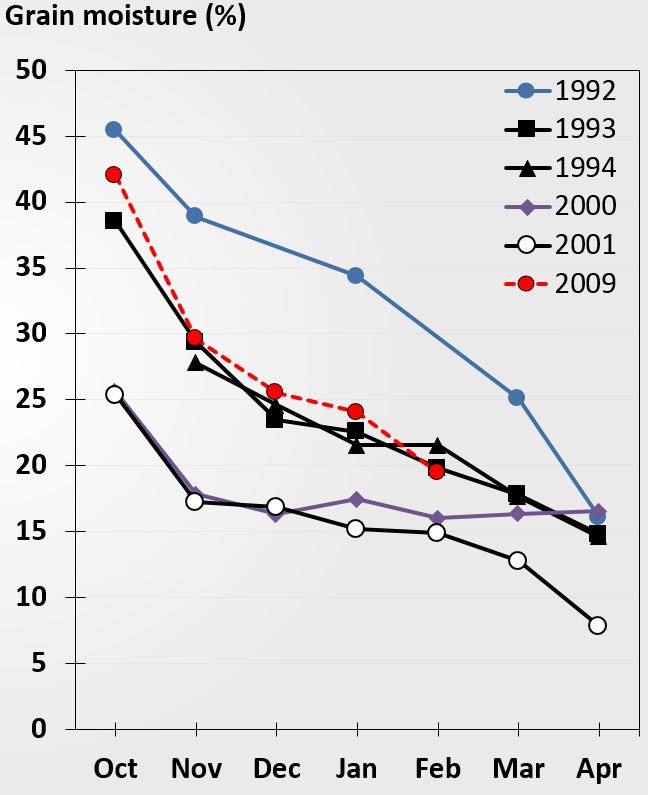
Success with precision farming (PF) is proving elusive. Technology used in PF is available and affordable, but the agronomy is lacking. A new exciting PF technology that is unmanned aerial vehicles (UAVs). UAVs with appropriate sensors have the potential to allow detection of in-season field problems early enough to be corrected.
In conclusion, the relative impact of corn management decisions on grain yield in Wisconsin varies the decision being made. Weather as the largest impact, but we can do little about it. The hybrid that you choose for your fields can have anywhere from a zero to almost 42% yield swing (70 bushels per acre for grain and 12,000 pounds of milk per acre for silage). The presence or absence of genetic traits can swing yield 0 to 100%. Crop rotation can impact grain yield from 0 to 30%. A May 1 versus June 1 planting date affect yield from 0 to 30% plus you would need to add the moisture penalty. Soil fertility can change yield by about a 20 to 50%. Plant densities of 39,000 versus 18,000 plants per acre represent a 0 to 22% yield change. With pest control, timeliness of pesticide application is everything. In corn, weeds are more important than insects, and insects are more important than
diseases. Tillage has a relatively small impact on yield representing a 5 to 10% change. However, practicing no-till can increase energy savings. Harvest timing can swing yield 0 to 20% between October 15 and December 1. Row spacing has a relatively small yield impact and represents a 0 to 5% yield change as row spacing decreases from 30 inches to 15 inches.